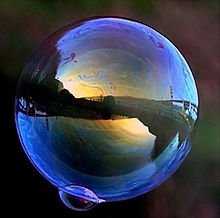
Pressure Surface Tension Merging Stability Color Change
Merging
When two bubbles merge, they typically do not become one enclosed sphere, because of the surface strength of the bubble. Instead, they stick together and adjust their shapes in order to minimize surface area and maximize overall strength, while remaining separate bodies of air.
http://en.wikipedia.org/wiki/Soap_bubble
When two bubbles of the same size merge together, the wall between them is flat, because their internal pressure is the same. When the bubbles are not of the same size, the shared wall tends to curve into the larger bubble, because the smaller bubble has higher internal pressure. If the pressure differential is very large, the smaller bubble will push into the larger bubble with enough force to break the barrier and they will become one bubble.
When three or more bubbles meet, they arrange themselves so that no more than three bubbles share a wall, and no more than four share an intersection. At these intersections, each bubble meets the shared wall at a 120° angle and meets every other bubble with an angle of 109.5°.
http://www.livescience.com/29465-bubbles-science-foam-physics.html

